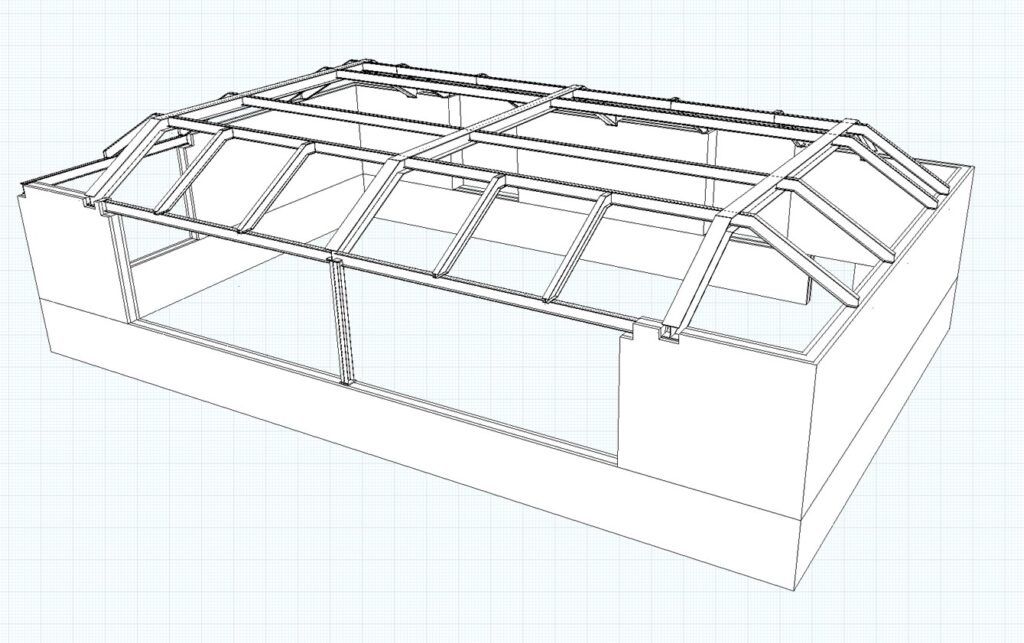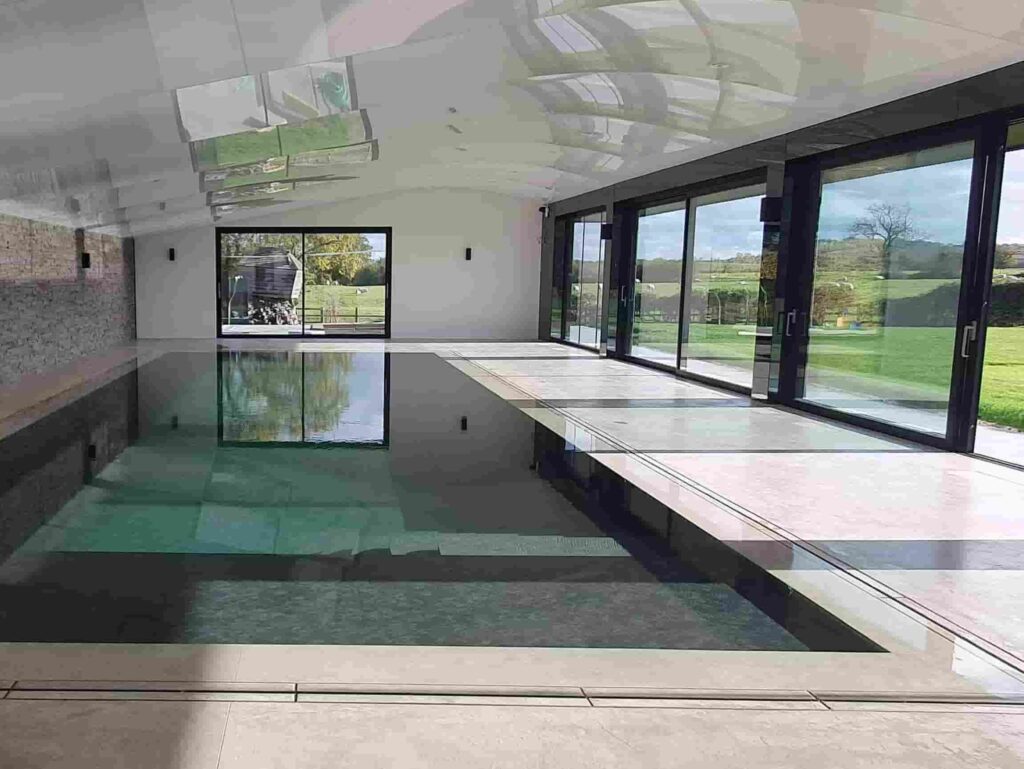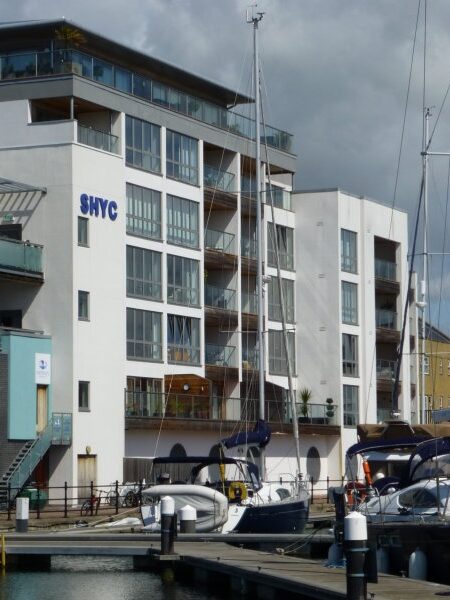What is ICF Construction?
Insulated Concrete Formwork (ICF) is a modern construction system that uses hollow, lightweight blocks made from Expanded Polystyrene Foam (EPS). Once assembled into a wall, concrete is poured into the void between the forms. This creates an incredibly strong, insulated, and fireproof wall for any building project. ICF construction combines the benefits of excellent insulation, structural integrity, and ease of use into one efficient system.

Why should you consider ICF construction?
Quick To Build
ICF systems are quick to install and don’t require rare and expensive joiners and bricklayers. This reduces labour costs and eliminates delays.
Indestructible
ICF structures are virtually indestructible, resistant to moisture, pests, fire and flooding.
Built To Last
The core marerials in an ICF form – concrete and the Neopor insulation do not deteriorate at all if protected from the environmnent by the wall finishes and so an ICF home could last forever!
Comfortable
ICF construction provides superior energy efficiency and eliminates draughts to provide an incomparably comfortable living environment.
Insulated Concrete Formwork
What is ICF?
Insulated Concrete Formwork is an in-situ Modern Method of Construction. It combines Neopor (A highly specialised type of expanded polystyrene) blocks with concrete to deliver superior levels of performance over alternative construction techniques like timber frame or cavity wall construction.
Neopor is a rigid, closed cell, thermoplastic foam material produced from solid beads of polystyrene that includes a polymeric flame retardant (PolymerFR), and graphite. After processing, it becomes a very lightweight, rigid, moisture proof material that has very high insulation qualities. The manufacturing process involved is complex but this wonderful material is absolutely ideal for the walls of very high quality disaster resistant domestic homes.
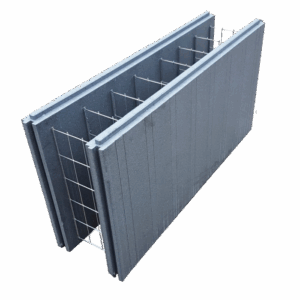
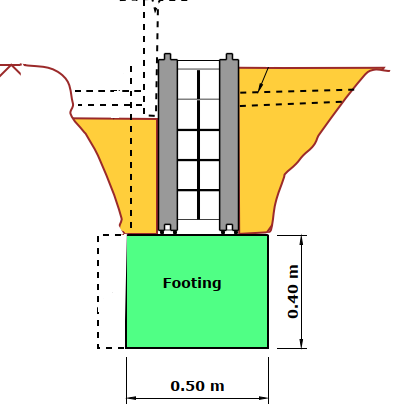
See how ICF Construction works!
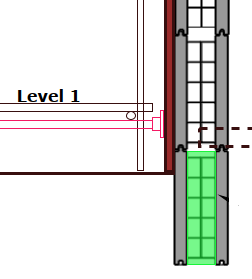
ICF In The UK
Block Systems
All ICF Construction systems available in the UK from members of the Insulated Concrete Formwork Association are known as block systems; although in the early stages of UK development the large area forms from Nudura and Polysteel would be have been referred to as panel forms.
Configuration
The basic module of a block system consists of parallel sheets of EPS, joined by polypropylene or steel wire cavity bridges acting as ties (Commonly known as webs), forming a hollow block, which is filled with concrete.
The blocks typically fit together by castellation or tongue and groove joints on the mating surfaces. Vertical joints are staggered as they are typically in blockwork.
Shape
In a typical range of block components with differing insulation wall thicknesses, the blocks range between 500–2500mm long and 250–600mm high.
In general, the larger the form the better because they are quicker to install and have less joints.
Joints
The type of joint is very important as they stop the concrete from leaking out!
Most of the forms have castellated joints restricted to the horizontal surfaces.
Polysteel has tongue and groove joints on both horizontal and vertical surfaces.
Benefits of ICF Construction
Comfort
Quality
Value
How Does ICF Compare?
ICF compared to Timber Frame or Cavity Wall Construction
| Characteristics | ICF | Timber Frame | Cavity Wall | Notes |
|---|---|---|---|---|
| Sound Proofing | Excellent | Poor | Average | The dense concrete and EPS layers provided by ICF is one of the most efficient methods of sound-proofing. |
| Long Term Maintenance | None | Unknown | Unknown | The life of timber frame and wide cavity wall construction has yet to be proven. |
| Service Installation | Ducts must be cast in walls | Needs Planning | Easy to Install | Slots can easily be cut into the EPS to accommodate cables and pipework. |
| Exterior Wall Finishes | Timber, Brick, Brick Slips or Render | Timber or Brick Skin | Brick Skin | ICF is very flexible as any type of wall finish can be accommodated. |
| Characteristic | ICF | Timber Frame | Cavity Wall | Notes |
|---|---|---|---|---|
| Anticipated Building Life | 100+ years | 30-60 years | 60+ years | Softwood timber will rot in the presence of moisture irrespective of any pressure treatment. |
| Thermal Mass | Very High | Very Low | Medium | SAP Calculations never accurately reflect the additional comfort & the reduced running costs of residential units with a very high thermal mass. |
| Resilience to Fire & Flood | High | Very Poor | Poor | It is impossible to ensure that structural timbers are properly dried out after a flood & cavity batts can take a significant time to fry out. |
| Thermal Bridging | Good | Poor | Poor | The continuity of the EPS panels reduces thermal bridging to a minimum. |
| Air-tightness (Draught-proofing) | Excellent | Poor | Poor | The June 2022 Building Regulation revisions require every new dwelling to be pressure tested before approval can be granted. |
| Carbon Footprint | Low | High | High | Heating & Cooling account for 90% of a building’s environmental impact. The airtightness and thermal efficiency of ICF results in low carbon impact. |
| Characteristics | ICF | Timber Frame | Cavity Wall | Notes |
|---|---|---|---|---|
| Speed of Construction up to wall plate | 1 Month Not weather dependent | 3-4 month order time + 4 weeks on site | 3-4 months & highly weather dependent | Once a builder has our drawings, they can start construction & weather-proof buildings in a few weeks and will not have to wait for bricklayers or kits from timber frame suppliers. |
| Required Scaffolding Period | 1 month | 1 month | 4 months | Required for the construction of the exterior walls, roof, gutters and down-pipes and windows. |
| Labour required | Experienced site workers | Joiners | Bricklayers | With some basic training, multi-house developments built in ICF can be completed in a few months. |
| Foundations | Strip footings or slab | Strip footings or slab | Strip footings or slab | Walls of a rigid rectangular box of ICF in residential units virtually never crack due to foundation movement. |
| Timber floor installation | Yes | Yes | Yes | Fixings are easily provided by casting screwed rods & plates into the concrete core of ICF walls to provide very secure, high strength fixings. |
| Beam & Block floors | Yes | No | Yes | Beams can be cast into the ICF walls. |
| Characteristics | ICF | Timber Frame | Cavity Wall | Notes |
|---|---|---|---|---|
| Materials | £100 | £100 | £120 | ICF forms £60, concrete £20 and concrete pump £20 Facing bricks £75, Cavity insulation £25 and Lightweight block inner skin £20 |
| Site Labour | £50 | £65 | £100 | Assumes machine made bricks |
| Brick Skin | £100 | £100 | inc | |
| Scaffolding | £15 | £10 | £25 | 12 weeks+ for cavity walls and 3 weeks for ICF and timber frame |
| Total (£/m2) | £265 | £275 | £245 | If render is used as the finish ICF is the cheapest form of Construction |
ICF Construction History
Quick & Cost Effective Construction
Durisol was founded in 1938 near Zurich in Switzerland. The forms were made from a mixture of treated wood fibers and Portland cement. They are completely different from modern ICF forms using EPS but were the first type of ICF to be used in volume. The company grew rapidly after WW2 in the Netherlands, France, and Belgium. There was a massive requirement for a quick, cost effective and solid construction method using largely unskilled labour.
Not Limited To Skilled Labour
Conservation of energy was the last concern for countries after WW2. Everyone needed buildings that were quick and easy to build and in post-war Europe. Durisol ICF quickly caught on as a quick, cost-effective and solid construction method that didn’t require highly skilled labour. By 1959 Durisol was promoted as cutting traditional construction costs by 20-30% and was being produced in 13 countries. Modern Insulated Concrete Formwork using EPS can be made very quickly in a large press whereas Durisol blocks used slow setting cement to bond the wood fibers together.
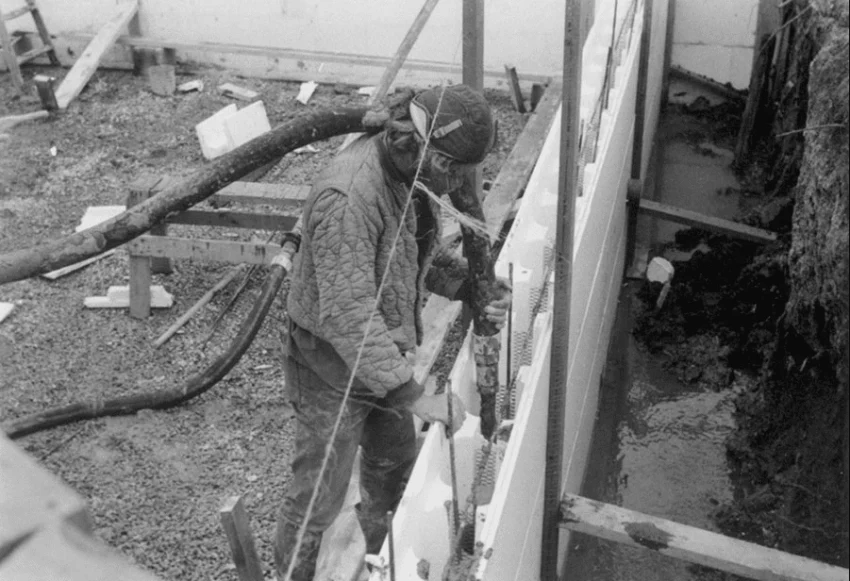
Polystyrene ICF
Polystyrene ICF didn’t appear until the late 1960s. The first person accredited with introducing a polystyrene ICF was contractor Werner Gregori. In 1966, he filed the first North American patent for a foam concrete form or “modern plastic” ICF. This was granted in the US and Canada in 1968 to cut construction costs, increase build speed, promote the use of unskilled labor and at the same time provide energy efficient home design.
American Polysteel
ICF forms were the start of what has become a mainstream sustainable house building system in the US and Canada. American PolySteel was founded in 1978 as Foam Form and was the first North American manufacturer. It procured the manufacturing rights from Werner Gregori, the Canadian who was issued the first patent for insulating concrete forms. American Polysteel sold the UK rights to Polysteel (UK) Ltd in 2008. The current Polysteel products, which include unique tongue and groove perimeter joints, are very similar to the original design by Werner Gregori.
It is just a matter of time before this sustainable house building system becomes more mainstream in the UK.
Need ICF Technical Advice?
Are you currently working on a building project? Do you want to maximise its potential by using ICF? Connect directly with our structural engineers for expert guidance and advice.
